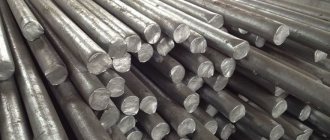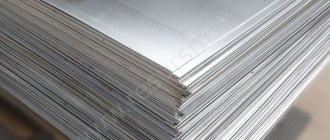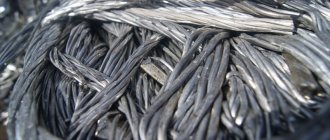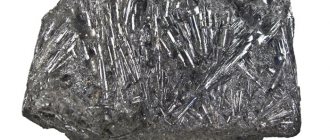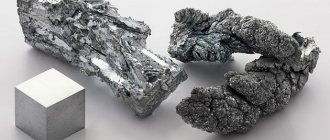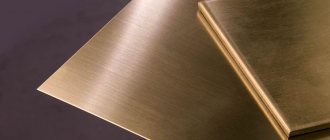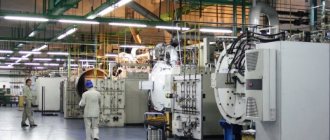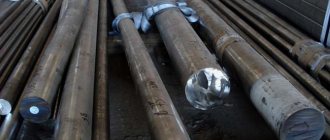Zinc is used in all areas of life
The specific heat capacity of zinc is of great importance for materials science and metallurgy. The values of this quantity in general for simple and complex substances, as well as for various materials, are very often used in life, industry and science. Without taking it into account, it is impossible to calculate energy costs for any type of production.
Zinc is a metal whose influence on all areas of human life is difficult to overestimate. Without zinc, there is no brass, which (although it is an alloy) is called an eternal metal for its excellent wear resistance. Brass finds application from aircraft and shipbuilding to printing and jewelry.
When fighting corrosion of metals and alloys, zinc takes first place. Galvanizing is a cheap and reliable way to impart anti-corrosion properties to materials. Various nutritional elements, without which the life of a modern person cannot do, are made on the basis of zinc. Even the human body cannot exist without zinc. This is the most common biologically active trace element after iron. Its deficiency leads to negative health consequences.
Properties of zinc
Chemical properties of zinc
Zinc is an active metal. At room temperature it fades and becomes coated with a layer of zinc oxide.
- Reacts with many non-metals: phosphorus, sulfur, oxygen.
- When the temperature rises, it reacts with water and hydrogen sulfide, releasing hydrogen.
- When fused with alkalis, it forms zincates - salts of zinc acid.
- Reacts with sulfuric acid, forming various substances depending on the concentration of the acid.
- When heated strongly, it reacts with many gases: chlorine gas, fluorine, iodine.
- Does not react with nitrogen, carbon and hydrogen.
Physical properties of zinc
Zinc is a hard metal, but becomes ductile at 100–150 °C. At temperatures above 210 °C it may become deformed. The melting point is very low for metals. Despite this, zinc has good electrical conductivity.
- Density - 7.133 g/cm³.
- Thermal conductivity - 116 W/(m K).
- The melting point of zinc is 419.6 °C.
- Boiling point - 906.2 °C.
- The specific heat of evaporation is 114.8 kJ/mol.
- The specific heat of fusion is 7.28 kJ/mol.
- Specific magnetic susceptibility - 0.175·10-6.
- Tensile strength - 200–250 MN/m2.
The detailed chemical composition of various grades of zinc is shown in the table below.
| Brand designation | Zinc, no less | Impurity, no more | |||||||
| lead | cadmium | iron | copper | tin | arsenic | aluminum | Total | ||
| TsV00 | 99,997 | 0,00001 | 0,002 | 0,00001 | 0,00001 | 0,00001 | 0,0005 | 0,00001 | 0,003 |
| CV0 | 99,995 | 0,003 | 0,002 | 0,002 | 0,001 | 0,001 | 0,0005 | 0,005 | 0,005 |
| CV | 99,99 | 0,005* | 0,002 | 0,003 | 0,001 | 0,001 | 0,0005 | 0,005 | 0,01 |
| Ts0A | 99,98 | 0,01 | 0,003 | 0,003 | 0,001 | 0,001 | 0,0005 | 0,005 | 0,02 |
| Ts0 | 99,975 | 0,013 | 0,004 | 0,005 | 0,001 | 0,001 | 0,0005 | 0,005 | 0,025 |
| C 1 | 99,95 | 0,02 | 0,01 | 0,01 | 0,002 | 0,001 | 0,0005 | 0,005 | 0,05 |
| Ts2 | 98,7 | 1,0 | 0,2 | 0,05 | 0,005 | 0,002 | 0,01 | 0,010** | 1,3 |
| Ts3 | 97,5 | 2,0 | 0,2 | 0,1 | 0,05 | 0,005 | 0,01 | — | 2,5 |
| * In zinc used for the production of TsAM4-1o alloy, the mass fraction of lead should be no more than 0.004%. ** In zinc used for rolling, the mass fraction of aluminum should be no more than 0.005%. | |||||||||
The content of impurities in zinc depends on the production method and the quality of the raw materials.
In Russia, the main percentage of zinc is obtained by the hydrometallurgical method - the metal is reduced from salts in solutions. This method allows you to obtain the purest metal. But some zinc is processed at high temperatures. This method is called pyrometallurgical.
Lead is a special impurity in zinc, since most of it is deposited due to insoluble anodes contained in the metal. Cathode zinc, in addition to all these impurities, consists of chlorine and fluorine.
What is specific heat capacity?
Thermal phenomena are studied by two sciences - thermodynamics and molecular physics. These sciences have different subjects of study, approaches and methods, but it is the accumulated knowledge of these disciplines that allows us to gain a true understanding of thermal phenomena.
Heat capacity in the case of both sciences acts as a key concept. The value is denoted by the Latin letter C. In a broad sense, heat capacity is considered as the physical property of a substance or material to absorb a strictly defined amount of heat when heated and release it during the reverse cooling process.
Any specific quantity is defined as a ratio that is realized to other completely different quantities taken as a unit. For example, to energy, mass or volume.
- In specific heat capacity the ratio is given to the product of mass and temperature. The formula for calculating specific heat capacity is: C = Q/m*(T2 – T1), where Q is the amount of heat in J, m is the mass of the substance in kg, (T2 – T1) is the difference between the final (T2) and initial ( T1) temperatures of the substance in degrees Kelvin.
- Thus, in the International System of Units (SI), specific heat capacity is measured in J/(kg.K). Its physical meaning can be determined by the question of how much heat is required to heat 1 kg of a given substance by 1°K.
- It is logical that when 1 kg of a substance is cooled by 1° (on the Kelvin or Celsius scale - it does not matter, since the value is equal to 1), heat will be released into the environment in the same amount that was spent on heating, and the value will acquire a negative value.
How do impurities change the properties of zinc
Manufacturers limit the content of cadmium, tin and lead in cast zinc alloys to suppress intergranular corrosion.
Tin is a harmful impurity. The metal does not dissolve and is released from the melt - it contributes to the fragility of zinc castings. Cadmium, on the contrary, dissolves in zinc and reduces its ductility when hot. Lead increases the solubility of the metal in an acidic environment.
Iron increases the hardness of zinc, but reduces its strength. At the same time, it complicates the process of filling molds during casting.
Copper increases the hardness of zinc, but reduces its ductility and resistance to corrosion. The copper content also interferes with the recrystallization of zinc.
The most harmful impurity is arsenic. Even with a small amount of it, the metal becomes brittle and less ductile.
To avoid edge cracking during hot rolling of zinc, the antimony content should not exceed 0.01%. When hot, it increases the hardness of zinc, depriving it of good ductility.
Zinc
PROPERTIES AND APPLICATIONS OF ZINC
Zinc (Zn) is a bluish-white metal, shiny when broken. The name of the element comes from the Latin word “zinc” - thorn, white jack - the characteristic color of its compounds. Zinc is a relatively soft metal - it is softer than tin, but harder than lead. When cold it is brittle, but when heated to 100-150°C it becomes plastic and can be rolled into thin sheets or drawn into wire. The ductility of cast zinc after deformation increases significantly. Zinc and its alloys have a low creep strength and significantly change their properties and dimensions during natural aging. The electrical conductivity of zinc is approximately 28%, and the thermal conductivity is 24% of the corresponding indicators of silver. The main (physical and mechanical properties of zinc) are given below:
| Atomic mass | 65,37 |
| Density at 20°C, g/cm3 | 7,13 |
| Temperature, °C | |
| melting | 419,5 |
| boiling | 907 |
| Specific heat of fusion, cal/g | 27,03 |
| Specific heat capacity at 18°С, cal/(g deg) | 0,1275 |
| Thermal conductivity at 20°С, cal/(cm·sec·deg) | 0,268 |
| Electrical resistivity at 20°C, ohm mm2/m | 0,063 |
| Modulus of normal elasticity, kg/mm2 | 800-1300 |
| Shear modulus, kg/mm2 | 800 |
| Yield strength of zinc, kg/mm2 | |
| cast | 7,5 |
| deformed | 8-10 |
| Tensile strength of zinc, kg/mm2 | |
| cast | 12-14 |
| deformed | 12-17 |
| annealed | 7-10 |
| Relative elongation of zinc, % | |
| cast | 0,3-0,5 |
| deformed | 42-50 |
| annealed | 10-20 |
| Hardness of zinc NV, kg/mm2 | 30-40 |
| Impact strength, kg/mm2 | 0,6-0,75 |
In dry air, zinc does not corrode. In water containing carbon dioxide and in humid air, it becomes covered with a thin, dense film of basic carbonate, which protects it from further corrosion. Water vapor and carbon dioxide oxidize zinc. Zinc dissolves in alkalis to form zincates and in acids to form the corresponding salts. Pure zinc is almost insoluble in sulfuric acid. At 500°C, zinc burns to form white zinc oxide powder. When heated, zinc oxide transforms into a lemon-yellow crystalline form. This substance sublimes when heated to 1100°C and above. Zinc oxide dissolves well in dilute sulfuric acid. Zinc forms alloys with many metals, including iron, nickel, copper, aluminum, silver, gold, bismuth, etc.
Zinc oxide is an infusible substance: when heated above 1800°C, it evaporates without melting. The temperature at which the reduction of zinc from carbon monoxide begins is about 950°C. Zinc sulfide ZnS is also infusible and is volatile at temperatures above 1180°C.
The main amount of zinc produced is spent as a protective coating on iron and steel products, as well as for the production of alloys: with copper (brass), with copper and aluminum ((aluminum bronze), with nickel and copper ((nickel silver and cupronickel), etc. Zinc is also included in bearing alloys.
The ability of zinc to form alloys with silver and gold is used in metallurgy to extract precious metals. Zinc dust is used for the precipitation of gold and silver from solutions when they are obtained by hydrometallurgical methods, as well as in the chemical industry and for purifying zinc solutions from copper and cadmium before their electrolysis.
Zinc sheets are used in the production of batteries, for the manufacture of tanks and plating of the underwater part of sea vessels. Small die-cast zinc parts are used in mechanical engineering. Zinc oxide is used to make white paint (zinc white), and also as an additive in the manufacture of automobile tires, glazes and glass, linoleum, oilcloth, and celluloid.
A solution of zinc chloride is used to protect wood from rotting. Zinc sulfate is used as a reagent in the flotation of ores, in the production of glue, matches and artificial fiber. Zinc compounds are used in medicine.
Deformed semi-finished zinc products (sheets, strips) have different properties along and across the rolled product, in particular higher tensile strength across the rolled product.
The properties of zinc change significantly under the influence of impurities. Lead, bismuth, antimony, and arsenic have very low solubility in zinc and negatively affect its technological properties.
Tin contained in zinc, when it solidifies, is released in the form of a eutectic, melting at a temperature of 199°C. If tin and lead are simultaneously present in zinc, a ternary eutectic is formed with a melting point of 150°C. Located along the boundaries of crystallites, the eutectic disrupts their connection, and during hot pressure treatment such an alloy is easily destroyed.
Iron increases the hardness and brittleness of zinc. When the iron content in zinc is above 0.2%, zinc rolling becomes more difficult due to its increased fragility.
Aluminum, magnesium and copper have a positive effect on the properties of zinc. With increased levels of lead, tin, cadmium or magnesium, the rate of corrosion of zinc increases, especially when exposed to hot water or steam. In contact with more electropositive metals, the corrosion rate of zinc increases sharply. In this regard, zinc is used as a protector for all more noble metals, with the exception of lead.
Under the influence of organic acids, such as acidic food products, zinc forms toxic salts (therefore it should not be used in the food industry. Organic neutral salts do not affect zinc.
Zinc alloys
Zinc-based alloys with the addition of copper, magnesium and aluminum have a low melting point and have good fluidity. They are easy to process, weld and solder.
Brass
There are two-component and multi-component brasses.
Two-component brass is a zinc alloy with a high copper content. There is yellow brass with copper in the amount of 67%, golden copper or tombac - 75%, and green - 60%. Such alloys can be deformed at temperatures of 300 °C.
Multicomponent brasses, in addition to the 2 main metals, consist of other additives: nickel, iron, lead or manganese. Each of the elements affects the properties of the alloy.
TsAM
TsAM is a family of zinc alloys. They contain magnesium, aluminum and copper. Such zinc alloys are used in foundries. They contain aluminum in the amount of 4%.
The main area of application of TsAM alloys is zinc die casting. Alloys of this family have low melting points and good casting properties. Their high strength allows the production of durable and complex parts.
Virenium
The alloy consists of zinc (24.5%), copper (70%), nickel (5.5%).
Thermal conductivity of steel, copper, aluminum, nickel and their alloys
Ordinary iron and non-ferrous metals have different structures of molecules and atoms. This allows them to differ from each other not only in mechanical properties, but also in thermal conductivity properties, which, in turn, affects the use of certain metals in various sectors of the economy.
table 2
Steel has a thermal conductivity coefficient at an ambient temperature of 0 degrees. (C) equal to 63, and when the degree increases to 600, it decreases to 21 W/m*degree. Aluminum, under the same conditions, on the contrary, will increase the value from 202 to 422 W/m*deg. Aluminum alloys will also increase thermal conductivity as the temperature increases. Only the value of the coefficient will be an order of magnitude lower, depending on the amount of impurities, and range from 100 to 180 units.
Copper, with a temperature change within the same limits, will reduce thermal conductivity from 393 to 354 W/m*deg. At the same time, copper-containing brass alloys will have the same properties as aluminum ones, and the thermal conductivity value will vary from 100 to 200 units, depending on the amount of zinc and other impurities in the brass alloy.
The thermal conductivity coefficient of pure nickel is considered low; it will change its value from 67 to 57 W/m*deg. Alloys containing nickel will also have a coefficient with a reduced value, which, due to the content of iron and zinc, ranges from 20 to 50 W/m*deg. And the presence of chromium will reduce the thermal conductivity in metals to 12 units, with a slight increase in this value when heated.
Zinc production
Metal mining
Zinc as a native metal does not occur in nature. It is mined from polymetallic ores containing 1–4% metal in the form of sulfide, as well as copper, lead, gold, silver, bismuth and cadmium. The ores are enriched by selective flotation and zinc concentrates (50–60% Zn) are obtained.
Zinc concentrates are fired in furnaces. Zinc sulfide is converted to ZnO oxide. This releases sulfur dioxide SO2, which is used in the production of sulfuric acid.
Metal production
There are two ways to obtain pure zinc from ZnO oxide.
The most ancient method is distillation. The fired concentrated composition is subjected to heat treatment to give it granularity and gas permeability.
The concentrate is then reduced with coke or coal at a temperature of 1200–1300 °C. The process produces metal vapors, which are condensed and poured into molds. The liquid metal is separated from iron and lead at a temperature of 500 °C. This achieves zinc with a purity of 98.7%.
Sometimes complex and expensive processing of zinc by rectification is used - separation of mixtures due to the exchange of heat between steam and liquid. This cleaning allows you to obtain metal with a purity of 99.995% and remove cadmium.
The second method of producing zinc is electrolytic. The calcined concentrate is treated with sulfuric acid. The finished sulfate solution is cleaned of impurities, after which it is subjected to electrolysis in lead baths. Zinc deposits on aluminum cathodes. The resulting metal is removed from the baths and melted in induction furnaces. After this, electrolytic zinc with a purity of 99.95% is obtained.
Metal casting
Hot zinc is a liquid and flowing metal. Thanks to these properties, it is easily filled into molds.
Impurities affect the amount of surface tension of the zinc. The technological properties of the metal can be improved by adding small amounts of lithium, magnesium, tin, calcium, lead or bismuth.
The higher the overheating temperature of zinc, the better it fills molds. When casting metal into cast iron molds, its volume decreases by 1.6%. This makes it difficult to produce large and long zinc castings.
Applications of zinc
To protect metals from corrosion
Pure zinc is used to protect metals from corrosion. The base is covered with a thin film. This process is called metallization.
In the automotive industry
Zinc-based alloys are used to decorate car interiors and in the production of door handles, locks, mirrors and windshield wiper housings.
Zinc oxide is added to car tires, which improves the quality of the rubber.
In batteries, accumulators and other chemical power sources, zinc is used as a material for the negative electrode. In the production of electric vehicles, zinc-air batteries are used, which have a high specific energy intensity.
In the production of jewelry
Jewelers add zinc to gold-based alloys. As a result, they are easy to forge and become plastic - they firmly connect small parts of the product to each other.
The metal also brightens jewelry, which is why it is often used in white gold.
Specific heat capacity of zinc
Since the heat capacity itself is directly dependent on temperature, the specific heat capacity of substances will vary depending on the values of this parameter. In the temperature range from 0 to 300°C, the specific heat capacity of zinc is approximately 400 J/kg.°C.
Melting zinc
- For comparison, we can give the value of this indicator for water at a temperature of 20°C, which corresponds to 4182 J/kg.K.
- Water has the highest specific heat capacity of any liquid or solid.
- In consumer terms, this means that the water heats up slowly and also cools down slowly.
Heating water requires a large amount of energy, which is why water is the most common industrial coolant. Accordingly, when water cools, it releases a significant amount of thermal energy into the environment. This is a universal coolant for various needs.
The specific heat capacity of zinc is approximately 10 times less than that of water. The metal heats up quickly and this requires much less heat.
The temperature dependence of the specific heat capacity of zinc is typical for simple metals. During heating, the value increases. This increase is insignificant and non-linear. When a metal reaches its melting point, when it turns into a liquid state, its specific heat capacity reaches a maximum and remains practically unchanged.
